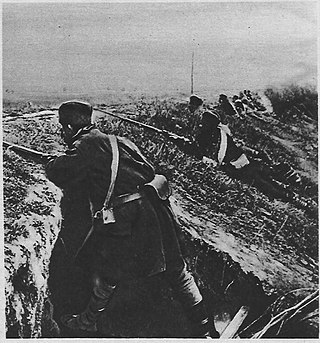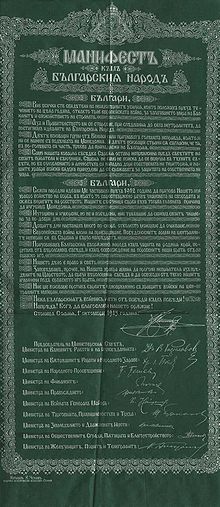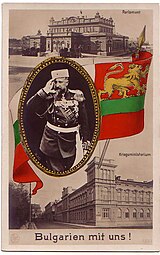The Bulgarian First Army was a Bulgarian field army during the Balkan Wars, World War I and World War II.

The Battle of Kirk Kilisse or Battle of Kirklareli or Battle of Lozengrad was part of the First Balkan War between the armies of Bulgaria and the Ottoman Empire. It took place on 24 October 1912, when the Bulgarian army defeated an Ottoman army in Eastern Thrace and occupied Kırklareli.

The Battle of Turtucaia, also known as Tutrakan Epopee in Bulgaria, was the opening battle of the first Central Powers offensive during the Romanian Campaign of World War I. The battle lasted for five days and ended with the capture of the fortress of Turtucaia and the surrender of its Romanian defenders.

The Morava Offensive Operation, was undertaken by the Bulgarian First Army between 14 October 1915 and 9 November 1915, as part of the strategic offensive operation of Army Group Mackensen against Serbia in 1915. Under the command of Lieutenant General Kliment Boyadzhiev, the Bulgarians seized the fortified areas of Pirot, Niš and the valley of the river Morava. As a result, the Serbian forces were compelled to retreat towards Kosovo and Metohija.
The Ovche Pole Offensive Operation was an operation of the Bulgarian Army that occurred between 14 October 1915 and 15 November 1915 as part of the Serbian campaign of 1915 in World War I. It aimed to seize the Vardar river valley and to cut the vital railway linking Skopje with Thessaloniki to prevent the Serbian Army from being resupplied and reinforced by the Franco-British Allied forces. The Bulgarian forces consisted of the Second Army under the command of Lieutenant General Georgi Todorov.

The Kingdom of Bulgaria participated in World War I on the side of the Central Powers from 14 October 1915, when the country declared war on Serbia, until 30 September 1918, when the Armistice of Salonica came into effect.

The Battle of Bazargic, also known as the Battle of Dobrich or the Dobrich epopee, , took place between 5 and 7 September 1916 between a joint Bulgarian–German-Ottoman force, consisting mainly of the Bulgarian Third Army, and a Romanian–Russian force, including a Division of Serbian Volunteers serving under the Russian 47th Corps. The battle was part of the Romanian campaign towards the end of 1916. It ended with a Central Powers victory.

Stefan Toshev was a Bulgarian general, from World War I. His mother was a teacher from the period of the National Revival. He volunteered in the Bulgarian Opalchentsi Corps during the Russo-Turkish War (1877–1878) and later served as a translator. On 10 May 1879, he graduated from the Military School in Sofia in its first year. Then he served in the Police force of Eastern Rumelia.

The Battle of Kircaali or Battle of Kardzhali was part of the First Balkan War between the armies of Bulgaria and the Ottoman Empire. It took place on 21 October 1912, when the Bulgarian Haskovo Detachment defeated the Ottoman Kırcaali Detachment of Yaver Pasha and permanently joined Kardzhali and the Eastern Rhodopes to Bulgaria. The anniversary of that event is celebrated annually on 21 October as a holiday of the city.
The Bulgarian Second Army was a Bulgarian field army during the Balkan Wars, World War I, and World War II.
The Bulgarian Third Army was a Bulgarian field army during the Balkan Wars, World War I, and World War II.

The First Battle of Cobadin, also known as the First Battle of the Rasova–Cobadin–Tuzla Line, was fought from 17 to 19 of September 1916 between the Bulgarian Third Army and the Romanian–Russian Army of the Dobruja. The battle ended in Entente tactical victory and forced the Central Powers to hold their offensive and assume a defensive stance till the middle of October.

The Second Battle of Cobadin took place from 19 to 25 October 1916 between the Central Powers, chiefly the Bulgarian Third Army, and the Entente, represented by the Russo–Romanian Dobruja Army. The battle ended in a decisive victory for the Central Powers; it resulted in the occupation of the strategic port of Constanța and the capture of the railway between that city and Cernavodă.

Ivan Kolev Stoyanov was a Bulgarian lieutenant general and distinguished cavalry commander during World War I.
The following is the Bulgarian order of battle at the beginning of the First Balkan War as of October 8, 1912. After its mobilization the field army counted for 366,209 men and represented half the field forces of the Balkan League. Its greater part was deployed in the main theater of the war in Thrace but the army also contributed to the allied war effort in Macedonia. This order of battle includes all combat units, including engineer and artillery units, but not medical, supply, signal and border guard units.

The following is the Bulgarian order of battle at the beginning of the second phase of the First Balkan War as of January 21, 1913. This order of battle includes all combat units, including engineer and artillery units, but not medical, supply, signal and border guard units.
The following is the Bulgarian order of battle at the start of the Second Balkan War as of 29 June [O.S. 16 June] 1913. This order of battle includes all combat units, including engineer and artillery units, but not medical, supply, signal, border guard and garrison units.
The First Battle of Caribrod took place during the Serbo–Bulgarian War on November 2, 1885 (O.S.) between the Royal Serbian Army and Bulgarian Army around Caribrod, today Dimitrovgrad, Serbia.

The 11th Macedonian Infantry Division was a Bulgarian military unit formed by Macedonian Bulgarians that operated in the First World War. The division is the successor of the Macedonian-Adrianopolitan Volunteer Corps.

The Bulgarian Front of First Balkan War was one of the heaviest fronts of the First Balkan War fought between 21 October 1912 and 3 April 1913















